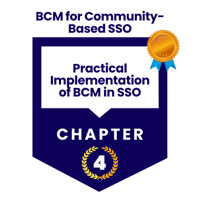Chapter 2
Understanding Business Continuity Management in Social Service Organisations
![[BCM] [SSO] [C2] Understanding BCM in Social Service Organisations](https://no-cache.hubspot.com/cta/default/3893111/8dbf8f0f-371f-437c-a7d7-ccaff00b9433.png) When we think of social service organisations, we often picture dedicated professionals supporting children, youth, and families through residential care, therapy, and outreach programs.
When we think of social service organisations, we often picture dedicated professionals supporting children, youth, and families through residential care, therapy, and outreach programs.
Yet, behind this important mission lies a critical question: what happens if a disruption prevents these services from being delivered?
This is where Business Continuity Management (BCM) comes in.
What is BCM?
 Business Continuity Management (BCM) is a structured approach that enables organisations to maintain essential operations during and after disruptions.
Business Continuity Management (BCM) is a structured approach that enables organisations to maintain essential operations during and after disruptions.
Unlike emergency response, which focuses on immediate safety and containment, BCM ensures that services can be maintained or recovered quickly to minimise impact.
For social service organisations, BCM is about much more than just protecting systems and buildings. It is about safeguarding lives, ensuring stability for vulnerable groups, and maintaining trust with parents, families, regulators, and donors.
Key Outcomes of BCM
Implementing BCM leads to three critical outcomes:
- Resilience – Building the organisational strength to withstand shocks, whether from a sudden facility outage or long-term staffing challenges.
- Preparedness – Equipping staff and volunteers with the knowledge and resources to respond effectively when disruptions occur.
- Recovery – Ensuring services can be restored quickly, with minimal disruption to the children and youth who rely on them every day.
These outcomes are not theoretical—they directly affect the safety and well-being of those in your care.
Common Disruptions in Social Service Organisations
Social service organisations face a unique set of risks, many of which can strike without warning. Some of the most common include:
Pandemics and Infectious Disease Outbreaks
The COVID-19 pandemic highlighted how vulnerable social services can be.
Residential facilities had to manage quarantine protocols, therapy sessions shifted online, and staff availability fluctuated. Such crises disrupt both care delivery and clients' emotional stability.
Fire, Power Failure, or IT System Outage
A fire in a residential facility or a sudden power outage can compromise safety and require an evacuation.
Similarly, if an IT system storing client records goes down, therapy sessions and case management may grind to a halt. These risks show why contingency planning is critical.
Staff Shortages or Attrition
Social services often depend on a small pool of specialised staff, such as therapists, counsellors, or caregivers.
Unexpected absences, high turnover, or illness can severely disrupt service delivery—especially for children with high support needs.
Supply Chain or Food Service Disruptions in Residential Care
Children in residential homes depend on reliable access to food, medicine, and daily necessities.
Any disruption in these supplies—whether due to vendor delays, transportation breakdowns, or wider crises—can compromise the well-being of those under care.
Security or Safety Incidents
Social service organisations must also be prepared for threats such as intruders, abuse allegations, or safety incidents involving children and staff.
How these are managed not only affects immediate safety but also shapes public trust in the organisation.
Why This Matters
For a charity or social service organisation, disruptions are not just “inconveniences.” They directly impact vulnerable individuals who rely on continuous care and stability.
A child missing therapy sessions may regress in progress, or a family losing access to counselling may face a more profound crisis.
Understanding BCM is therefore not about bureaucracy—it is about ensuring that services remain available when they are needed most.
More Information About Business Continuity Management Courses

 To learn more about the course and schedule, click the buttons below for the BCM-300 Business Continuity Management Implementer [B-3] course and the BCM-5000 Business Continuity Management Expert Implementer [B-5].
To learn more about the course and schedule, click the buttons below for the BCM-300 Business Continuity Management Implementer [B-3] course and the BCM-5000 Business Continuity Management Expert Implementer [B-5].
![Register [BL-B-3]*](https://no-cache.hubspot.com/cta/default/3893111/ac6cf073-4cdd-4541-91ed-889f731d5076.png) |
 |
 |
 |
 |
 |
![FAQ [BL-B-3]](https://no-cache.hubspot.com/cta/default/3893111/b3824ba1-7aa1-4eb6-bef8-94f57121c5ae.png) |
If you have any questions, click to contact us.
|
 |
 |
 |
 |





![[BCM] [SSO] [C1] BCM for Community-Based Social Services Organisations](https://no-cache.hubspot.com/cta/default/3893111/abcc60b1-a41a-47de-b0d5-84644744d776.png)
![[BCM] [SSO] [C3] Building a Practical BCM Framework for Social Service Organisations](https://no-cache.hubspot.com/cta/default/3893111/879387df-1aee-4517-8d38-fa33138b82ab.png)

![[BCM] [SSO] [C5] Case Study – Fire in a Residential Care Facility](https://no-cache.hubspot.com/cta/default/3893111/f18526eb-1b38-42a2-9c7d-52afe2121435.png)
![[BCM] [SSO] [C6] Governance and Sustainability in BCM](https://no-cache.hubspot.com/cta/default/3893111/fc72acdb-d95e-4823-b7bf-27ce15cc7542.png)
![[BCM] [SSO] [C7] Conclusion – Building a Culture of Care and Continuity](https://no-cache.hubspot.com/cta/default/3893111/b5cd16e6-e11f-4b42-8349-e043bab8187e.png)
![Email to Sales Team [BCM Institute]](https://no-cache.hubspot.com/cta/default/3893111/3c53daeb-2836-4843-b0e0-645baee2ab9e.png)

